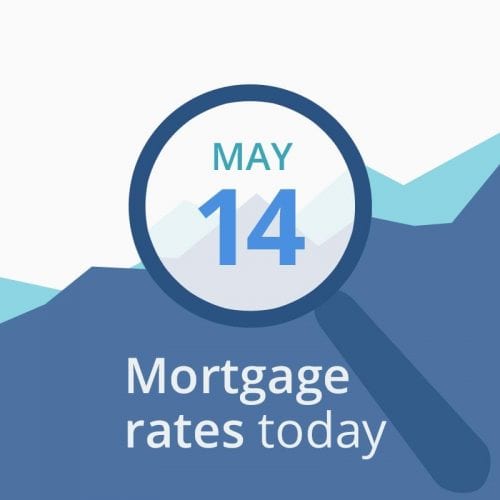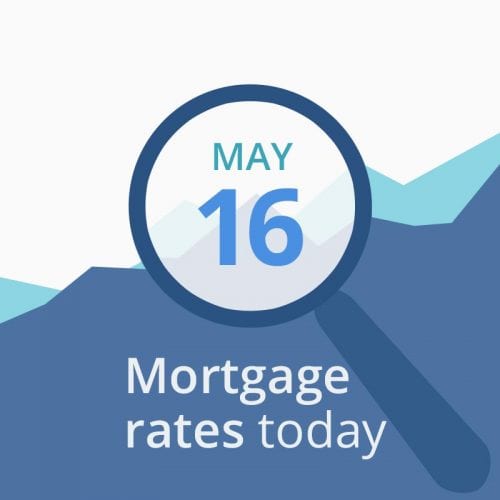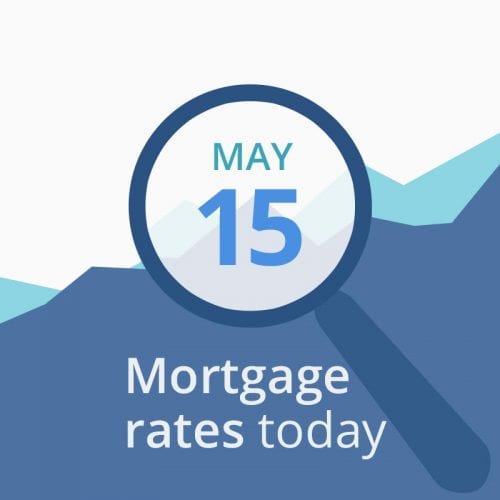
What’s driving current mortgage rates?
As we predicted, average mortgage rates fell appreciably yesterday. They’re now at their lowest in a month, which means they’re close to their lowest in more than 15 months. Now might be a very good time to lock your rate.
However, there may be hope of further falls in rates ahead. But, as always, that hope comes with some risks. To discover more, read on — and pay particular attention to the “China” section below.
The data below the rate table are indicative of mortgage rates holding steady or just inching either side of the neutral line today. Of course, at volatile times such as these, the chances of that prediction being overtaken by events are even higher than usual.
» MORE: Check Today’s Rates from Top Lenders (May 14, 2019)
| Program | Rate | APR* | Change |
|---|---|---|---|
| Conventional 30 yr Fixed | 4.125 | 4.125 | Unchanged |
| Conventional 15 yr Fixed | 3.688 | 3.688 | Unchanged |
| Conventional 5 yr ARM | 4 | 4.596 | -0.02% |
| 30 year fixed FHA | 3.625 | 4.612 | Unchanged |
| 15 year fixed FHA | 3.563 | 4.512 | Unchanged |
| 5 year ARM FHA | 3.625 | 5.061 | -0.01% |
| 30 year fixed VA | 3.75 | 3.925 | Unchanged |
| 15 year fixed VA | 3.688 | 4 | -0.06% |
| 5 year ARM VA | 3.688 | 4.294 | -0.01% |
| Your rate might be different. Click here for a personalized rate quote. See our rate assumptions here. | |||
Financial data affecting today’s mortgage rates
First thing this morning, markets looked set to deliver mortgage rates that are unchanged or barely changed today. By approaching 10:00 a.m. (ET), the data, compared with this time on Friday, were:
- Major stock indexes were all appreciably higher soon after opening (bad for mortgage rates). When investors are buying shares they’re often selling bonds, which pushes prices of Treasuries down and increases yields and mortgage rates. The opposite happens on days when indexes fall. See below for a detailed explanation
- Gold prices held steady at $ 1,299. (Neutral for mortgage rates.) In general, it’s better for rates when gold rises, and worse when gold falls. Gold tends to rise when investors worry about the economy. And worried investors tend to push rates lower)
- Oil prices inched back down to $ 61 from $ 63 a barrel (good for mortgage rates, because energy prices play a large role in creating inflation)
- The yield on 10-year Treasuries edged up to 2.41 percent from 2.40 percent. (Bad for borrowers). More than any other market, mortgage rates tend to follow these particular Treasury yields
- CNNMoney’s Fear & Greed Index inched up to 35 from 34 out of a possible 100. It was up at 74 this time last month. (Bad for borrowers. “Greedy” investors push bond prices down (and interest rates up) as they leave the bond market and move into stocks, while “fearful” investors do the opposite. So lower readings are better than higher ones
If nothing changes in coming hours, today might be noticeably quieter than yesterday for mortgage rates.
Verify your new rate (May 14, 2019)
China
Markets this morning are less spooked than yesterday. That’s at least partly a result of soothing remarks yesterday from President Tump. He held out hope of more progress in the U.S.-China trade talks. And told journalists: “We’ll let you know in three or four weeks if it’s successful,” according to NBC News.
That hope gave some welcome relief to markets around the world. They had a bad day yesterday as investors faced the possibility of an extended U.S.-China trade war. That has the potential to slow the entire global economy, as well as negatively affect the wealth of both participating nations.
Of course, America has the stronger economy. And it’s probably better positioned to win such a war. But, as with real, shooting wars, it’s not that straightforward. To start with, China is not a democracy and its leadership is subject to fewer pressures from politicians, public opinion and the media. Secondly, the cost of winning is likely to be considerable. And, thirdly, China is a major lender nation to the United States and has financial tools it could use to exert leverage. For example, a mass sell-off of U.S. Treasury bonds — or even a pause in purchasing new ones — could disrupt our ability to borrow.
Glimmer of hope?
By now, both sides presumably recognize that they’re in uncomfortable positions. However, they’ve also maneuvered themselves into situations where concessions are bound to be perceived domestically as weaknesses and failures. One possible scenario that was floated yesterday might provide a way forward. This sees the two leaders, Presidents Trump and Xi, take personal charge of negotiations. Between them, they should be able to construct a deal that carefully balances concessions with enough face-saving that each can sell the outcome back home as a win. A scheduled G20 summit at the end of next month would be a great opportunity to unveil such a deal. Perhaps President Trump had that event in mind in his remarks yesterday.
Until a deal or a truce is struck, there is likely to be a drag on the global economy that hits America and China especially hard. And that, in turn, is likely to exert downward pressure on mortgage rates. That’s not to say they won’t sometimes move up in response to other factors. But this trade war may well set a new direction that eventually emerges as a downward trend. However, any reduction to China’s buying of American government debt would likely have the opposite effect.
Rate lock recommendation
Trends
Trends are impossible to discern from just a few days’ changes. So don’t read too much into recent fluctuations. Frustrating though it is, there really is no way of knowing immediately what movements over a brief period mean in their wider context.
Even when one’s discernable, trends in markets never last forever. And, even within a long-term one, there will be ups and downs. Eventually, at some point, enough investors decide to cut losses or take profits to form a critical mass. And then they’ll buy or sell in ways that end that trend. That’s going to happen with mortgage rates. Nobody knows when or how sharply a trend will reverse. But it will. That might not be wildly helpful but you need to bear it in mind. Floating always comes with some risk.
Of course, it’s possible the Federal Reserve’s March statement on rates has established a long-term downward trend. But you can still expect to see rises and falls (such as those over the last several weeks) within it as other risk factors emerge and recede. And, depending on how near you are to your closing date, you may not have time to ride out any increases.
We suggest
That latest Fed announcement on interest rates didn’t move policy on from that declared after March’s meeting. That was doveish and ruled out further rate hikes this year. And it will likely continue to add some downward pressure on mortgage rates in coming months. As we’ve seen in recent weeks, that doesn’t mean there aren’t other risks (currently known and unknown) that could see them rise, possibly sharply. We suggest that you lock if you’re less than 30 days from closing.
Of course, financially conservative borrowers might want to lock immediately, almost regardless of when they’re due to close. On the other hand, risk takers might prefer to bide their time. Only you can decide on the level of risk with which you’re personally comfortable.
If you are still floating, do remain vigilant right up until you lock. Continue to watch key markets and news cycles closely. In particular, look out for stories that might affect the performance of the American economy. As a very general rule, good news tends to push mortgage rates up, while bad drags them down.
When to lock anyway
You may wish to lock your loan anyway if you are buying a home and have a higher debt-to-income ratio than most. Indeed, you should be more inclined to lock because any rises in rates could kill your mortgage approval. If you’re refinancing, that’s less critical and you may be able to gamble and float.
If your closing is weeks or months away, the decision to lock or float becomes complicated. Obviously, if you know rates are rising, you want to lock in as soon as possible. However, the longer your lock, the higher your upfront costs. On the flip side, if a higher rate would wipe out your mortgage approval, you’ll probably want to lock in even if it costs more.
If you’re still floating, stay in close contact with your lender, and keep an eye on markets. I recommend:
- LOCK if closing in 7 days
- LOCK if closing in 15 days
- LOCK if closing in 30 days
- FLOAT if closing in 45 days
- FLOAT if closing in 60 days
» MORE: Show Me Today’s Rates (May 14, 2019)
This week
It’s another relatively light week for economic reports. The two most likely to affect markets both occur on Wednesday: retail sales and industrial production.
Of course, it remains true that any economic report can cause waves if it contains sufficiently shocking data. But few if any of these are likely to fall into that category.
Forecasts matter
Markets tend to price in analysts’ consensus forecasts (below, we use those reported by MarketWatch) in advance of the publication of reports. So it’s usually the difference between the actual reported numbers and the forecast that has the greatest effect. That means even an extreme difference between actuals for the previous reporting period and this one can have little immediate impact, providing that difference is expected and has been factored in ahead. Although there are exceptions, you can usually expect downward pressure on mortgage rates from worse-than-expected figures and upward on better ones. However, for most reports, much of the time, that pressure may be imperceptible or barely perceptible.
- Monday: April survey of consumer expectations (consumers expect inflation to be at 2.6 percent in a year’s time, down from 2.8 percent in the last report)
- Tuesday: Nothing
- Wednesday: April retail sales (forecast +0.2 percent) and retail sales excl. autos (forecast +0.7 percent). Plus April industrial production (forecast -0.1 percent) and capacity utilization (forecast 78.6 percent)
- Thursday: April housing starts (forecast 1.205 million homes) and April building permits (forecast 1.296 million units)
- Friday: May consumer sentiment index (forecast 97.0 points)
Although these have the potential to move markets, expect headlines and general market sentiment to be more influential this week.
What causes rates to rise and fall?
Mortgage interest rates depend a great deal on the expectations of investors. Good economic news tends to be bad for interest rates because an active economy raises concerns about inflation. Inflation causes fixed-income investments like bonds to lose value, and that causes their yields (another way of saying interest rates) to increase.
For example, suppose that two years ago, you bought a $ 1,000 bond paying 5 percent interest ($ 50) each year. (This is called its “coupon rate” or “par rate” because you paid $ 1,000 for a $ 1,000 bond, and because its interest rate equals the rate stated on the bond — in this case, 5 percent).
- Your interest rate: $ 50 annual interest / $ 1,000 = 5.0%
When rates fall
That’s a pretty good rate today, so lots of investors want to buy it from you. You can sell your $ 1,000 bond for $ 1,200. The buyer gets the same $ 50 a year in interest that you were getting. It’s still 5 percent of the $ 1,000 coupon. However, because he paid more for the bond, his return is lower.
- Your buyer’s interest rate: $ 50 annual interest / $ 1,200 = 4.2%
The buyer gets an interest rate, or yield, of only 4.2 percent. And that’s why, when demand for bonds increases and bond prices go up, interest rates go down.
When rates rise
However, when the economy heats up, the potential for inflation makes bonds less appealing. With fewer people wanting to buy bonds, their prices decrease, and then interest rates go up.
Imagine that you have your $ 1,000 bond, but you can’t sell it for $ 1,000 because unemployment has dropped and stock prices are soaring. You end up getting $ 700. The buyer gets the same $ 50 a year in interest, but the yield looks like this:
- $ 50 annual interest / $ 700 = 7.1%
The buyer’s interest rate is now slightly more than seven percent. Interest rates and yields are not mysterious. You calculate them with simple math.
Show Me Today’s Rates (May 14, 2019)
Mortgage rate methodology
The Mortgage Reports receives rates based on selected criteria from multiple lending partners each day. We arrive at an average rate and APR for each loan type to display in our chart. Because we average an array of rates, it gives you a better idea of what you might find in the marketplace. Furthermore, we average rates for the same loan types. For example, FHA fixed with FHA fixed. The end result is a good snapshot of daily rates and how they change over time.
Mortgage Rates, Mortgage News and Strategy : The Mortgage Reports





